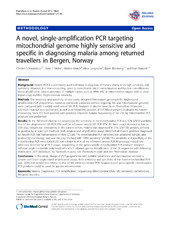A novel, single-amplification PCR targeting mitochondrial genome highly sensitive and specific in diagnosing malaria among returned travellers in Bergen, Norway
Haanshuus, Christel Gill; Mohn, Stein Christian; Mørch, Kristine; Langeland, Nina; Blomberg, Bjørn; Hanevik, Kurt
Peer reviewed, Journal article
Published version

Åpne
Permanent lenke
https://hdl.handle.net/1956/11775Utgivelsesdato
2013-01-22Metadata
Vis full innførselSamlinger
Originalversjon
https://doi.org/10.1186/1475-2875-12-26Sammendrag
Background: Nested PCR is a commonly used technique in diagnosis of malaria owing to its high sensitivity and specificity. However, it is time-consuming, open to considerable risk of contamination and has low cost-efficiency. Using amplification targets presented in multiple copies, such as rRNA 18S, or mitochondrial targets with an even higher copy number, might increase sensitivity. Methods: The sensitivity and specificity of two newly designed Plasmodium genus-specific single-round amplification PCR programmes, based on previously published primers targeting 18S and mitochondrial genome, were compared with a widely used nested 18S PCR. Analyses of dilution series from Plasmodium falciparum reference material were performed, as well as retrospective analyses of 135 blood samples, evaluated by routine microscopy, from 132 fever patients with potential imported malaria. Sequencing of the 220 bp mitochondrial PCR products was performed. Results: At the threshold dilution 0.5 parasites/μl, the sensitivity of the mitochondrial PCR was 97% (29/30 parallels), that of the single-round 18S PCR 93% and the reference nested 18S PCR 87%. All three assays detected as low as 0.05 p/μl, though not consistently. In the patient cohort, malaria was diagnosed in 21% (28/135) samples, defined as positive by at least two methods. Both single-round amplification assays identified all malaria positives diagnosed by nested PCR that had sensitivity of 96% (27/28). The mitochondrial PCR detected one additional sample, also positive by microscopy, and was the only method with 100% sensitivity (28/28). The sensitivity and specificity of the mitochondrial PCR were statistically non-inferior to that of the reference nested PCR. Microscopy missed two infections detected by all PCR assays. Sequencing of the genus-specific mitochondrial PCR products revealed different single nucleotide polymorphisms which allowed species identification of the 28 sequences with following distribution; 20 P. falciparum, six Plasmodium vivax, one Plasmodium ovale and one Plasmodium malariae. Conclusions: In this study, design of PCR programmes with suitable parameters and optimization resulted in simpler and faster single-round amplification assays. Both sensitivity and specificity of the novel mitochondrial PCR was 100% and proved non-inferior to that of the reference nested PCR. Sequencing of genus-specific mitochondrial PCR products could be used for species determination. Keywords Malaria Diagnostics PCR Amplification Sequencing Mitochondrial DNA 18S Sensitivity Gametocytes Returned travellers
